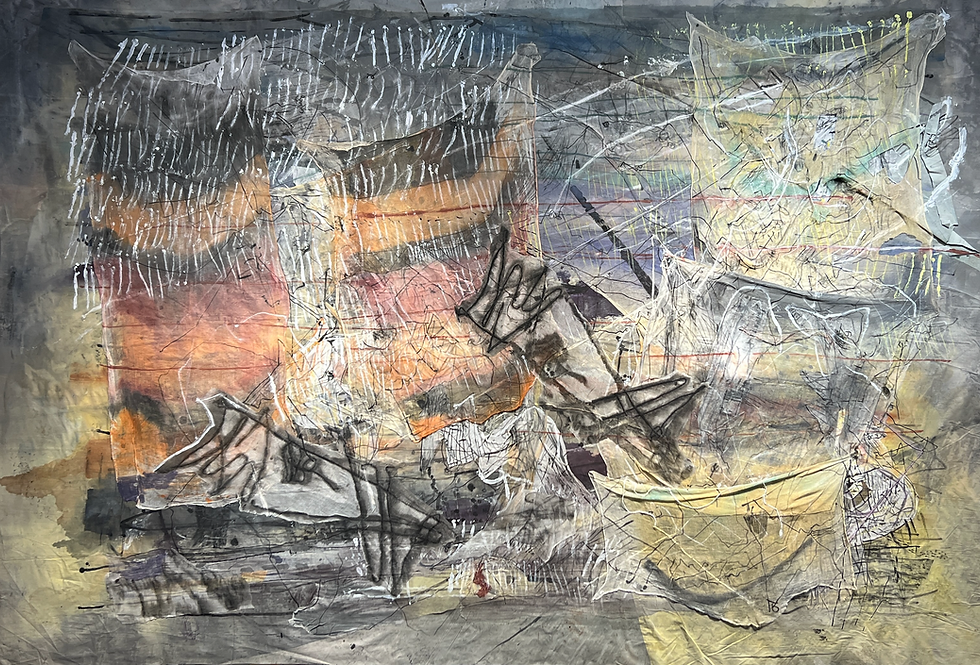In early 2023, Iva began what would become a year-long correspondence with Patrick Theimer that explores the tenacity and ambition of her multidisciplinary practice. The following is an excerpt from that exchange, and the full conversation will become available soon. Be sure to stay connected for more...
I do find it interesting your progression from Dona in the Garden to Nestinarki to Flower Mother. It seems you were at your tapestries, you needed to work forward, you deconstructed order to rediscover the natural, and now you are embracing renewal in the disorder of abstracted transgressions. Do you find progress in entropy?
Iva
I agree until you mention progress. I love painting because time gets caught in the messiness of the layers and it moves in all directions at once, even ones we cannot immediately see. Yes, time lends a progression. But the word “progress” tends to imply a “bettering”, and I think it gets used to justify a lot of unforgivable forgetting of ways we have been. The Futurists (I do love many of their creations) fell in love with speed and machines, mechanisms of progress. But these were really just abstractions which made them also susceptible to falling in love with fascism. Picasso is interested in people and their bodies. Miro paints the stars and planets but in real, embodied ways connecting them always to his imagination, his symbology and the land. So for me it's again about attention and tuning into the liminal and the peripheral. It’s the strangeness of the world that I lean into.

Patrick:
So nature is entropy, disorder is the natural world?
Iva:
Yes. Though I’m always weary of binaries. Dis-order I think is perhaps a more useful term. It’s the flux, the perpetual state of becoming, reorganizing, reconfiguring, etc. but remaining interconnected and in process. And every gesture is an expression of a metamorphic cluster. I think we forget that on a material level we are all the same star stuff. I love the charts of embryo development and the different stages we go through in the womb. I was an amphibian once. That’s a thought that delights me. I have access to knowledge of their world, and that's a thought that gives me relief.
So though I explore relational theories such as entropy, fractals, quanta, etc., I find that poetry is better suited to express how painting allows me to think and pay attention to processes that defy scientific consensus and perceived reality. For example, CA Conrad’s practice of somatic poetry and ritual resonates especially and I believe their ability to sense the vibrations of recently extinct animals. The binary relationship nature/culture is thus mute. And their poetry is the form these field recordings seek and shape.
Patrick:
Your paintings explore identity in disorder by holding accountable the structure of memory.
Iva:
I keep thinking about how memory works in my day-to-day life in the studio. I don’t think it’s typically a conscious recalling. Images, smells, sensations… they all pulse through me and then I am looking at the painting and recognizing the possibilities. So it’s optical, but the prism of memory makes the flow very tactile. Perhaps that’s the bend or the structure you refer to. Memory intercepts the optical and bends it into a mushy cacophony of knowledge, which then produces a rhythm, a lived reaction. It helps when my attention is very relaxed or distracted from any sort of particular “knowing”. The paintings then become constructed not as compositions but as membranes of undulating nodes, systems clustering density with relaxed juxtapositions rather than just focal points or figure/ground perspectives. It’s that entropy, distinguished from chaos.
My recent paintings are dense reliefs constructed over many months with layers of gauze and paint. I build these terrains because I need to touch, and through this touch I recover, record and practice haptic memory. I don’t recall the source of this image but it resonates: a recently blind man traces the face of a beloved child. And of Cezanne, whose fast and wandering line is all about touching.
Comentários